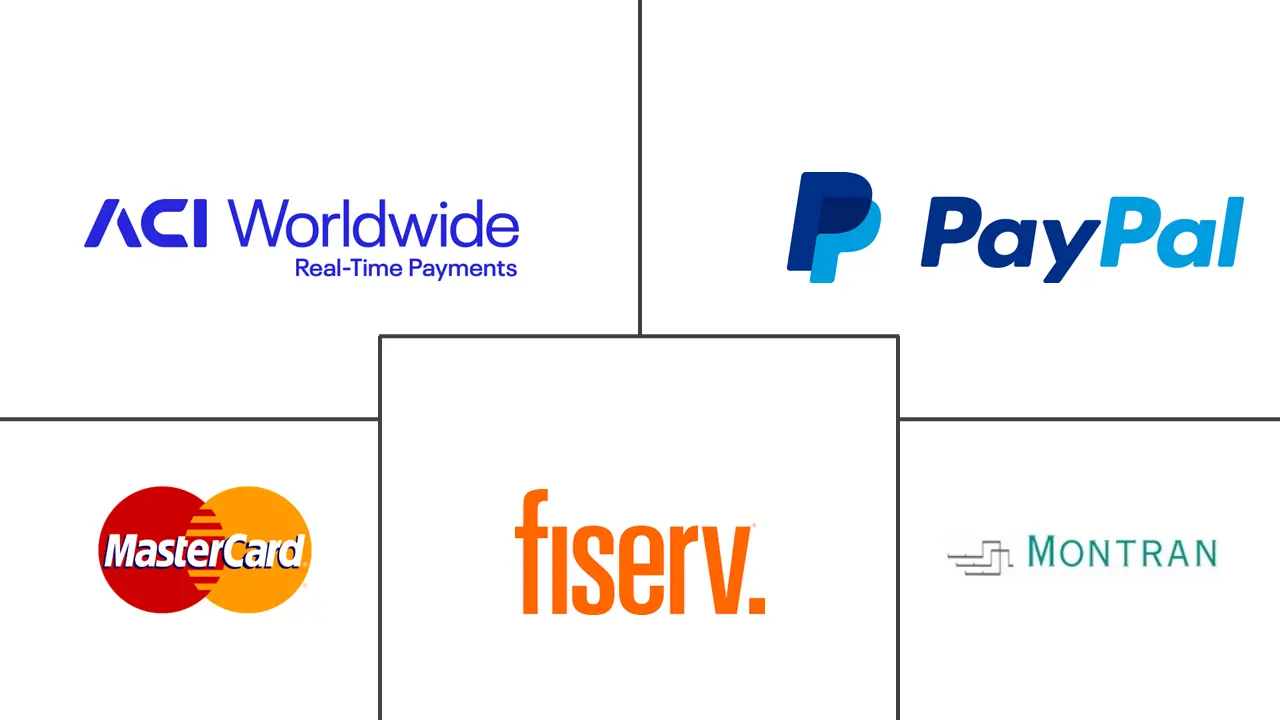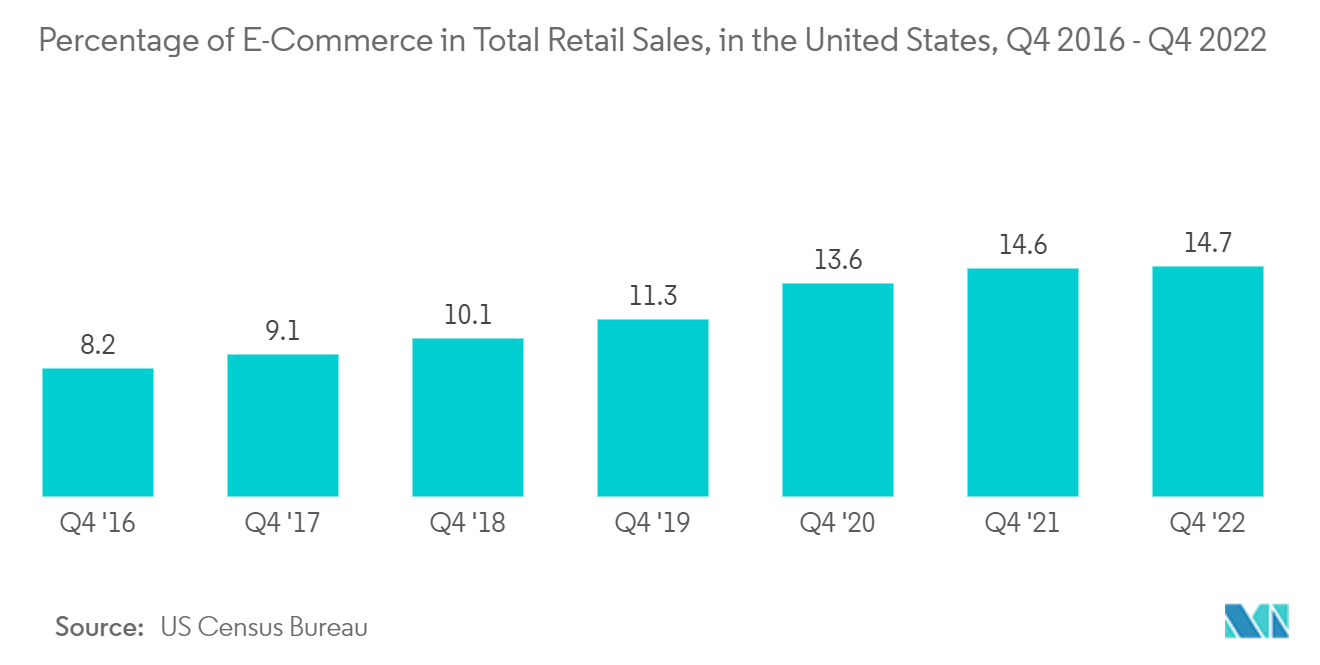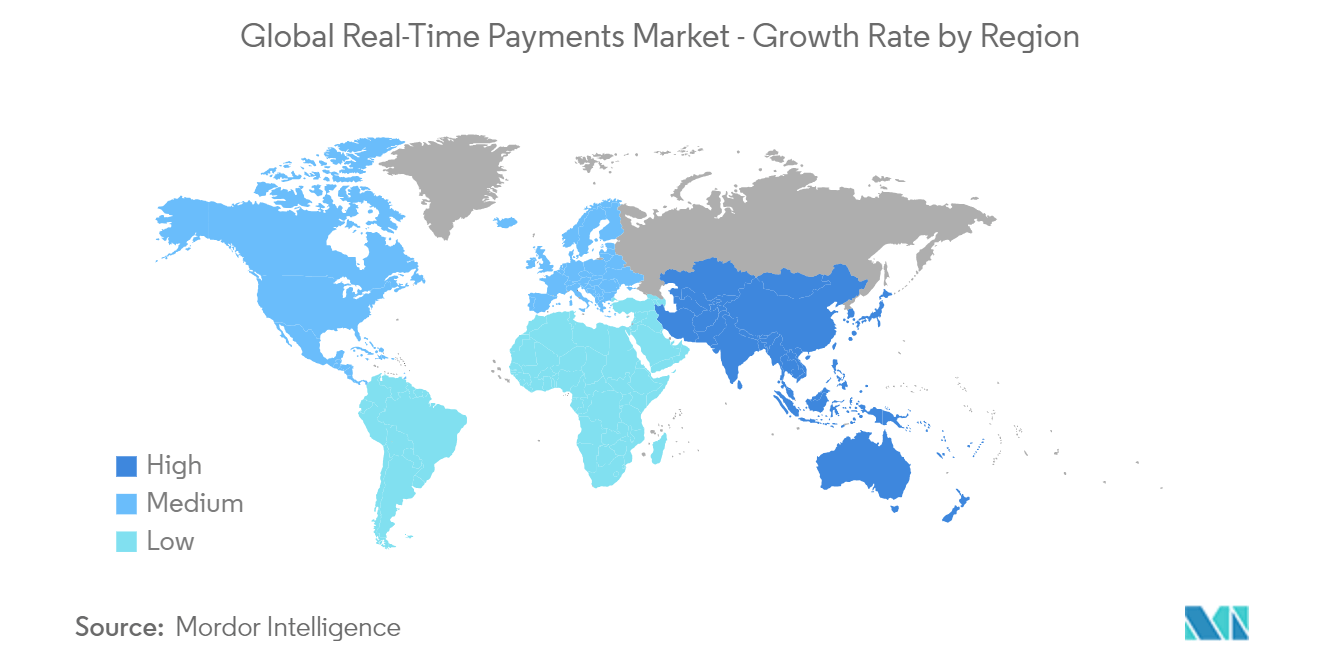Real Time Payments Market Size

| Study Period | 2019 - 2029 |
| Market Size (2024) | USD 25.92 Billion |
| Market Size (2029) | USD 116.23 Billion |
| CAGR (2024 - 2029) | 35.00 % |
| Fastest Growing Market | Asia-Pacific |
| Largest Market | North America |
Major Players
*Disclaimer: Major Players sorted in no particular order |
Real Time Payments Market Analysis
The Real-Time Payments Market size is estimated at USD 25.92 billion in 2024, and is expected to reach USD 116.23 billion by 2029, growing at a CAGR of 35% during the forecast period (2024-2029).
Real-time payments typically focus on low-value retail payment systems (RPS); they differ from real-time gross settlement systems (RTGS) and distributed ledger payment systems. In addition to meeting the demands and expectations, real-time payments have generated interest from regulators, competition authorities, and payment service providers. Regulators believe that instant payments will expand access to banking services, support economic growth, provide alternatives to Visa/Mastercard networks and reduce the use of cash and cheques.
- There is rapid growth in the global Real-Time Payment (RTP) ecosystem, with businesses and governments realizing the benefits of implementing faster, more efficient payment systems. Currently, over 70 countries on six continents support real-time payments, with USD 195 billion in transaction volume this year, presenting a year-on-year growth of 63%, according to ACI Worldwide's March 2023 report.
- The growing penetration of smart devices and booming online retail commerce across the world are driving the rapid adoption of real-time payments. Increasingly, demanding consumers are turning to their smartphones when they need to pay merchants, billers, peers, and others.
- The increasing focus on using advanced technologies and new business models in the Fintech sector, like open API-enabled real-time payment systems using mobile applications, has contributed to market growth. As per a study by Finastra last year, Baas (Banking as a Service) is expected to grow by 25% over the next three years, providing various features to users embedded in the system like real-time payment, retail banking, etc., and 86% players in the market are planning to adopt open APIs to enable available banking capabilities.
- The COVID-19 pandemic resulted in increased use of digital payments across the world. According to the Global Findex Database 2021, in low and middle-income economies (excluding China), more than 40% of adults who made merchant in-store or online payments by using a card, phone, or through the internet did so for the first time since the start of COVID-19.
- However, with real-time payments gaining widespread adoption, there is a significant increase in the risk of fraud. With most payment types, a customer has the ability to recall a payment made in error before it is processed. However, an instant payment is completed in a few seconds, and as it is irrevocable, the payer cannot cancel the transaction. Such factors increase the challenges in combating fraud in the case of real-time payments.
Real Time Payments Market Trends
P2B Segment Holds the Key to Drive the Market
- P2B payments refer to monetary transactions between (to or from) businesses and customers. The unabated growth of mobile-based transactions and e-commerce is a key factor driving the development of the segment.
- The continuous growth of online shopping and e-commerce sales is expected to drive the development of the segment. P2B payments allow businesses to improve customer satisfaction. The P2B structure has been picking up the pace with the change in regulatory reforms. Online and in-store bill payments promise the next wave of huge volumes needed to keep real-time costs cheaper than cards.
- Also, lower-cost P2B transactions offer a new level of cash management to businesses that can benefit from real-time liquidity owing to instant settlement along with the added level of service to the consumer related to the instant notification of the status of the transaction.
- In the gig economy, the labor markets are characterized temporarily. Examples of jobs that comprise the (just-in-time workforce) include food delivery services, ride-hailing services (such as Uber or Bolt), house sitters, and dog walkers. Real-time payments make it big and beneficial to gig economy workers because workers are paid quickly, allowing them to better plan their finances without worrying about cash-related transactions.
- The increasing trends for cloud-based real-time payment solutions can be attributed to their flexibility in providing real-time payment insights to retailers. The growing adoption of digital payment methods in big retail stores across the globe is anticipated to drive the market in the forecasted period.

Asia Pacific will be the Fastest Growing Market
- Real-time transaction growth forecasts for emerging countries will be the key to taking the market to a new level, with countries like India leading and outpacing developed nations. Governments around the world that enable real-time schemes are driving prosperity and economic growth by providing businesses and consumers with faster, cheaper, and more efficient payment methods.
- United Payments Interface (UPI) has transformed how Indians make payments, allowing them to quickly transfer money instantly from one bank account to another: from a customer to a business or between individuals. According to Mastercard's 2022 New Payments Index, Indians are the most willing of any consumers in the Asia-Pacific region to use emerging cashless payment methods, with 93% likely to have made such a payment in the previous year.
- As per the CEBR, India accounted for the highest volume of real-time payments among businesses globally, with over 40% of all such payments made throughout last year originating in the country. India made 48.6 billion real-time payments last year, which was around 2.6 times higher than China, which was in second place with 18.5 billion real-time transactions.
- According to the CEBR, net benefits for businesses and consumers of real-time payments hit USD 15.397 billion in China, supported by real-time accounting for 5.7% of all transactions. Based on current real-time adoption levels in China, instant payments unlocked a total transaction value of USD 170.800 billion per day last year through a reduced float time. This working capital facilitated an estimated USD 12.411 billion in business output in the same year.
- In Hong Kong, real-time payments share was recorded at 7.3% last year, which is estimated to triple (22.8% by 2026), as per CEBR. The strongly predicted real-time uptake will result in consumer and business benefits reaching USD .26 billion in 2026. The macroeconomic benefits of using real-time payments were an estimated USD .34 billion of economic output (0.09% of formal GDP) last year, equivalent to the output of 3,355 workers.

Real Time Payments Industry Overview
The competitive rivalry in the Real-Time Payments Market is moderately high, as the market comprises many large vendors that command a prominent market share besides having access to well-established distribution networks. With consumer preferences changing rapidly, the Real-Time Payments Market has become a lucrative option and, thus, has attracted huge investments. The service providers are engaging in partnerships to promote product innovation. Some of the prominent vendors in the market include ACI Worldwide Inc., Fiserv Inc., Paypal Holdings Inc., and Mastercard Inc.
In June 2022, ACI Worldwide announced its new mobile engagement platform ACI Smart Engage, enabling merchants worldwide to serve up their inventory of services and goods directly to consumers' smartphones using voice, location, and image recognition technology, taking shopping-on-the-go to a new level.
Furthermore, in April 2022, Fiserv launched Appmarket for financial institutions, where they can access a curated set of fintech solutions to help them operate more efficiently, reach new customers, and compete more effectively. AppMarket would empower Fiserv financial institution clients and address emerging gig economy banking and crypto finance opportunities, small and mid-size business (SMB) lending and other priorities.
Real Time Payments Market Leaders
-
ACI Worldwide Inc.
-
Fiserv Inc.
-
Paypal Holdings Inc.
-
Mastercard Inc.
-
Montran Corporation
*Disclaimer: Major Players sorted in no particular order
.webp)
Real Time Payments Market News
- Apr 2023: Visa announced a partnership with PayPal and Venmo to pilot Visa+, an innovative service that aims to enable individuals to move money quickly and securely between different person-to-person (P2P) digital payment apps. Later in 2023, Venmo and PayPal users in the United States will be able to start moving money seamlessly between the two platforms.
- Apr 2023: CRED introduced its UPI-based P2P payments, providing its users with a new payment option. The feature enables CRED members to access 'pay anyone' through their contact list, phone numbers, or UPI IDs.
Real Time Payments Market Report - Table of Contents
1. INTRODUCTION
- 1.1 Study Assumptions and Market Definition
- 1.2 Scope of the Study
2. RESEARCH METHODOLOGY
3. EXECUTIVE SUMMARY
4. MARKET INSIGHTS
- 4.1 Market Overview
- 4.2 Value Chain Analysis
-
4.3 Industry Attractiveness - Porter's Five Forces Analysis
- 4.3.1 Threat of New Entrants
- 4.3.2 Bargaining Power of Buyers
- 4.3.3 Bargaining Power of Suppliers
- 4.3.4 Threat of Substitutes
- 4.3.5 Intensity of Competitive Rivalry
- 4.4 Assessment of the Impact of COVID-19 on the Market
5. MARKET DYNAMICS
-
5.1 Market Drivers
- 5.1.1 Increased Smartphone Penetration
- 5.1.2 Ease of Convenience
- 5.1.3 Falling Reliance on Traditional Banking
-
5.2 Market Challenges
- 5.2.1 Payment Fraud
- 5.2.2 Existing Dependence on Cash
-
5.3 Market Opportunities
- 5.3.1 Government Policies Encouraging the Usage of Digital Payment is Expected to Aid the Growth of Real-Time Payment Methods
- 5.4 Key Regulations and Standards in the Digital Payments Industry
- 5.5 Analysis of Major Case Studies and Use-cases
- 5.6 Analysis of Real Payments Transactions as a Share of all Transactions with a Regional Breakdown of Key Countries by Transaction Volume
- 5.7 Analysis of Real Payments Transactions as a Share of Non-Cash Transactions with a Regional Breakdown of Key Countries by Transaction Volume
6. MARKET SEGMENTATION
-
6.1 By Type of Payment
- 6.1.1 P2P
- 6.1.2 P2B
-
6.2 By Geography
- 6.2.1 North America
- 6.2.1.1 United States
- 6.2.1.2 Canada
- 6.2.2 Europe
- 6.2.2.1 United Kingdom
- 6.2.2.2 Germany
- 6.2.2.3 Spain
- 6.2.2.4 Sweden
- 6.2.2.5 Finland
- 6.2.2.6 Rest of Europe
- 6.2.3 Asia-Pacific
- 6.2.3.1 China
- 6.2.3.2 India
- 6.2.3.3 South Korea
- 6.2.3.4 Thailand
- 6.2.3.5 Japan
- 6.2.3.6 Rest of Asia-Pacific
- 6.2.4 Latin America
- 6.2.4.1 Brazil
- 6.2.4.2 Argentina
- 6.2.4.3 Colombia
- 6.2.4.4 Mexico
- 6.2.4.5 Rest of Latin America
- 6.2.5 Middle-East and Africa
- 6.2.5.1 United Arab Emirates
- 6.2.5.2 South Africa
- 6.2.5.3 Nigeria
- 6.2.5.4 Rest of Middle-East and Africa
7. COMPETITIVE LANDSCAPE
-
7.1 Company Profiles
- 7.1.1 ACI Worldwide Inc.
- 7.1.2 Fiserv Inc.
- 7.1.3 Paypal Holdings Inc.
- 7.1.4 Mastercard Inc.
- 7.1.5 Montran Corporation
- 7.1.6 Temenos AG
- 7.1.7 Volante Technologies Inc.
- 7.1.8 Wirecard AG
- 7.1.9 FIS Global
- 7.1.10 Visa Inc.
- 7.1.11 Finastra
- *List Not Exhaustive
8. INVESTMENT ANALYSIS
9. FUTURE OF THE MARKET
** Subject To AvailablityReal Time Payments Industry Segmentation
Real-time payment is an inter-bank, fully electronic payment system in which irrevocable funds are transferred from one bank account to another and where confirmation back to the originator and receiver of the payment is available in one minute or less.
The Real-Time Payments Market is Segmented by Type of Payment (Person-to-Person (P2P) and Person-to-Business (P2B)) and Geography (North America (the United States and Canada), Europe (United Kingdom, Germany, Spain, Sweden, Finland, and the Rest of Europe), Asia-Pacific (China, India, South Korea, Thailand, Japan, and the Rest of Asia-Pacific), Latin America (Brazil, Argentina, Colombia, Mexico, and the Rest of Latin America), and Middle-East and Africa (United Arab Emirates, South Africa, Nigeria, and the Rest of Middle-East and Africa)). The market sizes and forecasts are provided in terms of value (USD) for all the above segments.
| By Type of Payment | P2P | |
| P2B | ||
| By Geography | North America | United States |
| Canada | ||
| By Geography | Europe | United Kingdom |
| Germany | ||
| Spain | ||
| Sweden | ||
| Finland | ||
| Rest of Europe | ||
| By Geography | Asia-Pacific | China |
| India | ||
| South Korea | ||
| Thailand | ||
| Japan | ||
| Rest of Asia-Pacific | ||
| By Geography | Latin America | Brazil |
| Argentina | ||
| Colombia | ||
| Mexico | ||
| Rest of Latin America | ||
| By Geography | Middle-East and Africa | United Arab Emirates |
| South Africa | ||
| Nigeria | ||
| Rest of Middle-East and Africa |
Real Time Payments Market Research FAQs
How big is the Real-Time Payments Market?
The Real-Time Payments Market size is expected to reach USD 25.92 billion in 2024 and grow at a CAGR of 35% to reach USD 116.23 billion by 2029.
What is the current Real-Time Payments Market size?
In 2024, the Real-Time Payments Market size is expected to reach USD 25.92 billion.
Who are the key players in Real-Time Payments Market?
ACI Worldwide Inc., Fiserv Inc., Paypal Holdings Inc., Mastercard Inc. and Montran Corporation are the major companies operating in the Real-Time Payments Market.
Which is the fastest growing region in Real-Time Payments Market?
Asia-Pacific is estimated to grow at the highest CAGR over the forecast period (2024-2029).
Which region has the biggest share in Real-Time Payments Market?
In 2024, the North America accounts for the largest market share in Real-Time Payments Market.
What years does this Real-Time Payments Market cover, and what was the market size in 2023?
In 2023, the Real-Time Payments Market size was estimated at USD 19.20 billion. The report covers the Real-Time Payments Market historical market size for years: 2019, 2020, 2021, 2022 and 2023. The report also forecasts the Real-Time Payments Market size for years: 2024, 2025, 2026, 2027, 2028 and 2029.
Real Time Payments Industry Report
Statistics for the 2024 Real Time Payments market share, size and revenue growth rate, created by Mordor Intelligence™ Industry Reports. Real Time Payments analysis includes a market forecast outlook to 2029 and historical overview. Get a sample of this industry analysis as a free report PDF download.



